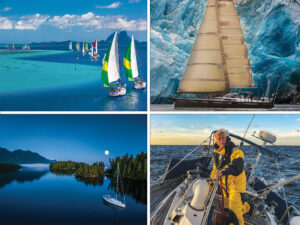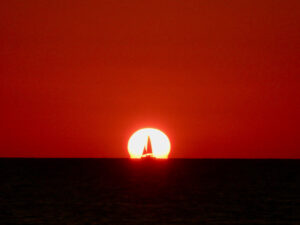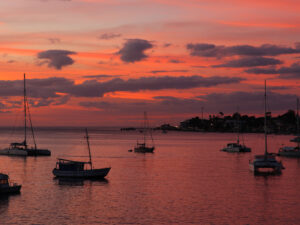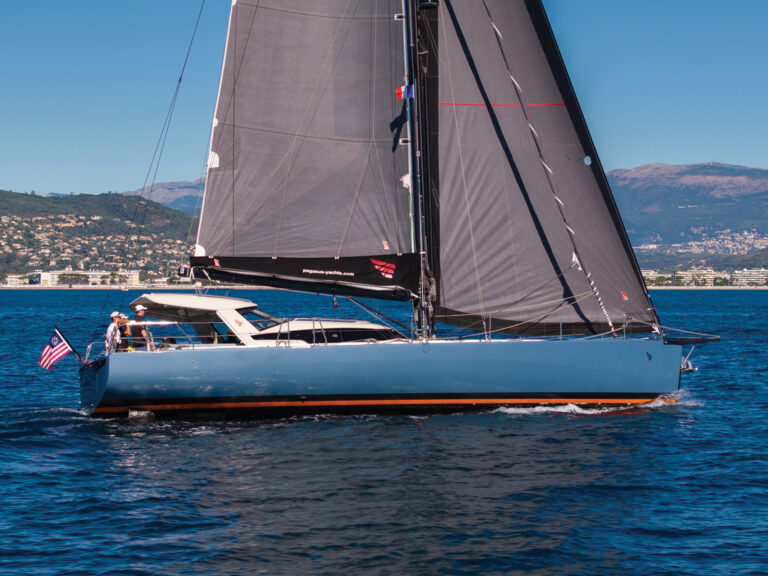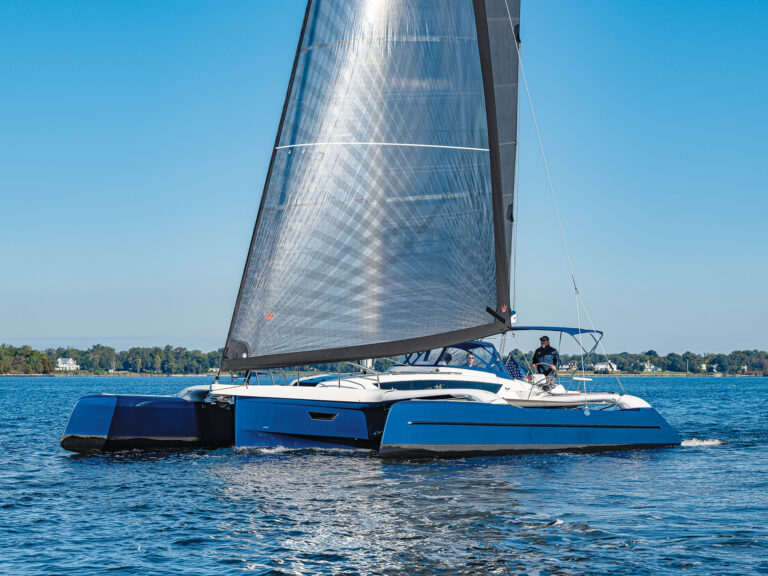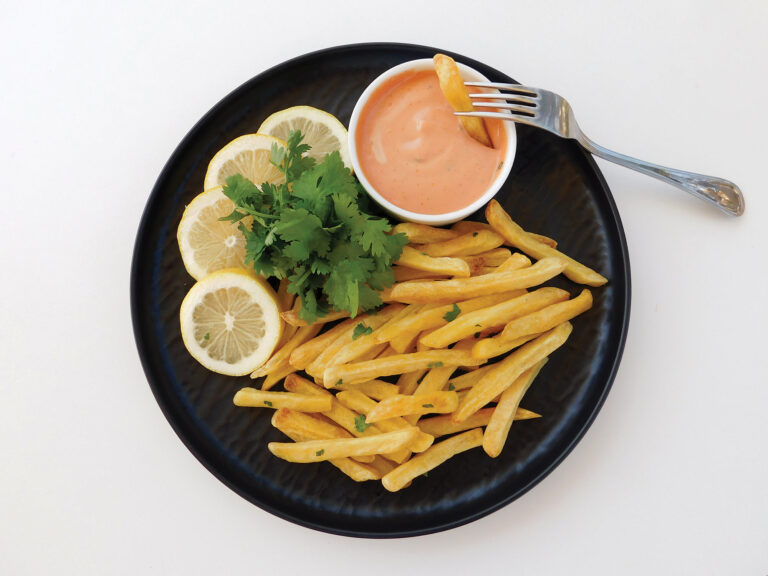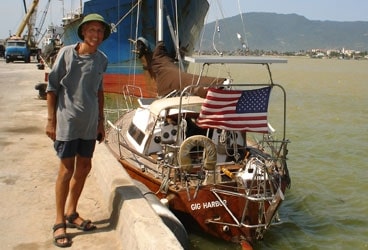
OmmenVietnam368
For 40 years after I was stationed here in the early sixties I dreamed of returning to Vietnam. When I finally made it back, onlookers who’d gathered at the quay in Danang to watch Fleetwood’s arrival saw me kiss the ground. Since that emotional moment, I’ve cruised this country’s beautiful coast, and rekindled my love for this place and its people. The Vietnamese have pulled themselves out of the misery in which we left them, and built a better place than I remember from 1963. Except for the bi-annual sailboat race from Hong Kong to Nhatrang held for the last decade, the number of cruising boats that have visited Vietnam in the last 25 years could be counted on two hands.
Do Not Enter Here
My first attempt to enter Vietnam was at Haiphong. I intended to sail through the incredible beauty of Ha Long Bay. Before I arrived it was difficult to obtain information on Vietnam’s entry requirements, and I’ve since learned-the hard way-that Vietnam is well set up to receive commercial shipping, but doesn’t yet know what to do with pleasure boats. Before leaving for Vietnam I searched the Internet and inquired at the consulates in San Francisco and Manila. I sent an e-mail to the Port of Haiphong a week before, advising of my arrival date; it went unanswered. When I was within 25 miles of Haiphong I raised the port authority on channel 16. They advised me to contact the harbor pilot, who directed me to stand by at a position 15 miles from the harbor, in the rough Gulf of Tonkin, where I anchored.
At 1 p.m. the following day, three seasick border patrol officers arrived, and boarded Fleetwood. We filled out forms, then the least-seasick officer stayed aboard to direct me up the Red River. I tied to a 250-foot Coast Guard cutter downstream from Haiphong. Two port-control officers boarded. More forms. The border-patrol officer took my passport and clearance papers from my last port, saying he’d return the next day with the immigration officer. The next day, nothing. The border patrol posted a guard over me. The first night he sat on the Coast Guard cutter; the next he slept in my cabin.
Finally, after calling their chief for permission, the friendly Coast Guardsmen invited me aboard, let me use their showers, and threw a great dinner with many rounds of Lieu Moi, their rice alcohol. The third day a port-control officer and immigration officer returned, and told me to leave by morning. I wasn’t allowed to make any phone calls, or use my radio.
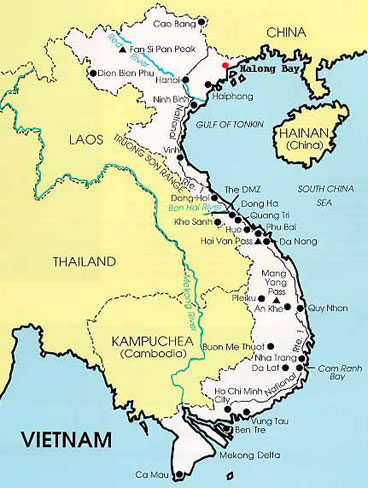
Second Try
It was a four-day sail to Danang, during which I exchanged e-mails with the American Embassy in Hanoi, asking how to avoid the Haiphong experience. They said I needed to use an agent, as the commercial ships do. I called the port-control office at Danang, they suggested Mr. Tran Van Vui of Falcon Shipping who gave me an estimate of the check-in fees ($400 to $500). The next morning the pilot boarded, guided me into the river port, and directed me to tie up on the quay near another Coast Guard cutter.
Navigation was straightforward. Mr. Tran came to the boat right away and accompanied me to the port-control office. Again, lots of forms and tons of copies. I said I planned to visit the old imperial city, Hue, and also Hanoi. Port control wanted my exact schedule, requiring that I have a police guard at the boat when I was gone overnight. Finally, from the back of my agent’s motorbike, as I saw Danang’s wide tree-lined streets, sidewalk cafes, French colonial buildings, and charcoal-fired sidewalk food stalls, my memories flooded back.
The Imperial City
I took a $3 roundtrip bus to Hue-the imperial capital city of Vietnam until 1946-where I rented a bicycle and rode the back streets. The familiar smells of exotic woods drew me into a shop where an old man was building models of historic boats. I was invited to join a Buddhist funeral party, drank tea with a family of boatmen on the river and stayed in a small hotel for $8. A day or two later I flew to Hanoi, rented a bike, and rode along the French-style boulevards looking at impressive colonial buildings, Hoan Kiem Lake with its promenades and pagoda temple, and a centuries-old bakery where I was invited in for a taste of rice wine. Later a group of men smoking a water pipe asked me to hunch down and share the smoke.
On to Nha Trang
The coastline from Danang to Nha Trang features miles of pristine beaches fronting the distant mountain ranges of the Central Highlands. The biggest challenge was keeping clear of the fishing boats, particularly at night. During daylight they’d come alongside for lively conversation. The port-control and pilot routine was repeated at Nha Trang, though the port-control officer let me proceed without pilot into Nha Trang. It’s a pretty entrance with small islands, and the larger Hon Tre Island to the east, with its beautiful coves and white sandy beaches that would make ideal anchorages for cruisers, if they’ll ever let us go. (Charterers are free to explore this entire area. Sunsail has a base in Nha Trang.)
A launch met me with my agent, Mr. Chau, and the immigration officer. They showed me where to anchor, and then processed the trillion documents. The next morning, Mr. Chau showed me around on his motorcycle. I was invited to join a party on the promenade under the trees; they shared my favorite, pickled calamari and Lieu Moi. The toast is “Yo!”
There was another yacht at Nha Trang. Vellamo is a Swan 48 from Jamestown, Rhode Island, with Phillip and Denise Gibbins, who came arrived from the South Pacific via the Philippines, China, and Hong Kong. Nha Trang was to be their one stop in Vietnam. They used Saigon Tourist Services as agent (also agent for the Hong Kong-to-Nhatrang race), and paid $700 for Nha Trang entry. I paid just over $400, including $10 per day moorage and guard service for the two nights I visited Hue and Hanoi.
Next I met Allan Goodman, an Australian businessman who specializes in making arrangements for yachts visiting Vietnam-at the moment his clientele consists of super yachts rather than cruising boats, due to the high cost of entry. Goodman also acts as the Nha Trang administrative host of the yacht race, and is developing a marina in the old port area and another facility for charter boats in Danang near China Beach. Now that Vietnam is opening up to business and investment, the authorities have asked him to submit a plan for making Vietnam more yacht-accessible. At the moment, even locals can’t go out in a pleasure boat without a permit.
Disappointment
I’d hoped to sail Fleetwood up the Saigon River to Saigon-the route we followed when I arrived there in 1961 on a small aircraft carrier, the USS Core with our helicopter company-but costs are prohibitive (pilot fee $1,000; again, fees are based on commercial vessels). I took a night bus from Nha Trang to Saigon. This was the part of my journey I’d been looking forward to most. I’d been drafted, still a Dutch citizen, in January 1961; our helicopter unit had been the first company-strength unit deployed in Vietnam. When our ship moored at the foot of Saigon’s main street, a contingent of press people recorded the event. From high on the flight deck, I’d recognized an old Amsterdam friend who was operating a camera, and yelled: “Ed van Kan!” The rest of my company had no idea what was going on. We hadn’t been told where we were going when we left Fort Lewis, Washington; most of the men hadn’t a clue where Vietnam was, or what was going on there. I’d been first off the ship because-against orders-I’d packed civilian clothes; the South Vietnam government didn’t want uniformed soldiers roaming Saigon. Ed took me to the Continental Hotel for my first Tiger beer, and introduced me to his press-corps friends, including Peter Arnett, who worked for Reuters at the time. I had such a good time in Saigon that I urged my wife to join me. She stayed a year, teaching English. I extended my tour in Vietnam to my discharge date, stayed on, traveled through the neighboring countries, and returned to Santa Barbara, California in March 1963.
On my return, to Saigon I was eager to see how Vietnam had recovered and changed after the war. I rented a $1-a-day bike and rode out to the familiar sites. The wonderful Continental Hotel, where expats and the press corps once hung out, with its open porch and fanned ceilings, is now a sterile air-conditioned enclosed facade. But over at Givral, which author Graham Greene called “the Milk Bar” in his classic novel The Quiet American, time stood still. I sat down and savored the flan, in the same spot where I’d had my first flan 45 years previously. I rode to Le Loi Boulevard, to the Rex hotel, and had a beer on the same roof where my unit had once eaten Thanksgiving dinner. I went on a tour of the busy waterway of the Mekong Delta. One of these days, yachts will be able to navigate it all the way to Phnom Penh-but that day is far in the future.
It’s probably premature to put Vietnam on your cruising schedule. But one day the country will open up and cruisers will have the time of their lives. The people, the beauty of the country, its rich history, and its proximity to Laos, Cambodia, Thailand, and the Philippines will make Vietnam a popular destination in the far east. The government is working on making the country more accessible to visiting yachts, but these things take time.
If You Go
You’ll need a tourist visa ($75), it’s good for 90 days and is extendable. Visas can be obtained at any Vietnamese consular section; it took me 10 minutes in Manila. You’ll need a shipping agent, these agents usually handle only large commercial vessels; most have branches in major Vietnamese ports. I used Falcon Shipping Company: main office Ho Chi Minh City (falconship.hcm@hcm.vnn.vn; phone: 84-8-930097); in Danang, Mr. Tran Van Vui (falcon@dn.falconship.com or falconshipdn@dng.vnn.vn; phone 84-511-887611); in Nha Trang, Mr. Nguyen Chau (falconshipkh@dng.vnn.vn; phone 84-58-514641). The main tourist and ship-clearing agency (state-owned) is Saigon Tourist Company (www.saigon-tourist.com). Allan Goodman operates GMIO’Seas Inc. (gmi@pacific.net.sg; cell 0001-84-91-8509701). He’s not an agent (he uses Falcon to process the official paperwork) but he may be of great service to cruisers bringing their boats to Vietnam. His business currently is developing a marina in Vietnam, and acting as liaison with agents and visiting private superyachts. This experience makes him an invaluable resource for any cruising boats hoping to enter Vietnam.
Jack van Ommen set out from Gig Harbor, Washington, in February 2005 aboard his Nafa 30-foot mahogany-plywood, clear-varnished kit boat, Fleetwood, built in 1979. Read more about his circumnavigation on his website (www.cometosea.us).

